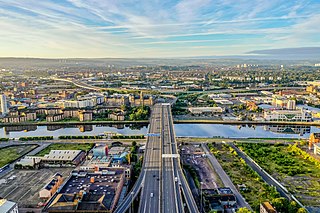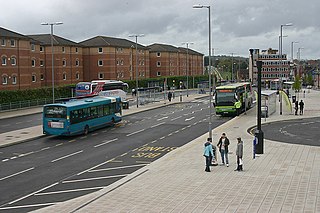
Bristol Parkway, on the South Wales Main Line, serves the villages of Stoke Gifford and Harry Stoke in South Gloucestershire, England. Despite its name, it is located in Gloucestershire rather than Bristol itself. It is 112 miles (180 km) from London Paddington. The station was opened in 1972 by British Rail and rebuilt in 2001. It is the third-most heavily used station in the West of England combined authority area, after Bristol Temple Meads and Bath Spa. There are four platforms, and a well-equipped waiting area. The station is managed by Great Western Railway, who provide most of the trains at the station, with CrossCountry providing the rest.

Manchester Piccadilly is the main railway station of the city of Manchester, in the metropolitan county of Greater Manchester, England. Opened originally as Store Street in 1842, it was renamed Manchester London Road in 1847 and became Manchester Piccadilly in 1960. Located to the south-east of the city centre, it hosts long-distance intercity and cross-country services to national destinations including London, Birmingham, Nottingham, Glasgow, Edinburgh, Cardiff, Bristol, Exeter, Plymouth, Reading, Southampton and Bournemouth; regional services to destinations in Northern England including Liverpool, Leeds, Sheffield, Newcastle and York; and local commuter services around Greater Manchester. It is one of 19 major stations managed by Network Rail. The station has 14 platforms: 12 terminal and two through platforms. Piccadilly is also a major interchange with the Metrolink light rail system with two tram platforms in its undercroft.

The M32 is a 4.4-mile-long (7.1 km) motorway in South Gloucestershire and Bristol, England. It provides a link from the M4, a major motorway linking London and South Wales, to Bristol city centre and is maintained by National Highways, the national roads body.

A park and ride, also known as incentive parking or a commuter lot, is a parking lot with public transport connections that allows commuters and other people heading to city centres to leave their vehicles and transfer to a bus, rail system, or carpool for the remainder of the journey. The vehicle is left in the parking lot during the day and retrieved when the owner returns. Park and rides are generally located in the suburbs of metropolitan areas or on the outer edges of large cities. A park and ride that only offers parking for meeting a carpool and not connections to public transport may also be called a park and pool.

The city of Glasgow, Scotland, has a transport system encompassing air, rail, road and an underground light metro line. Prior to 1962, the city was also served by trams. Commuters travelling into Glasgow from the neighbouring local authorities of North and South Lanarkshire, Renfrewshire, East Renfrewshire, and East and West Dunbartonshire have a major influence on travel patterns, with tens of thousands of residents commuting into the city each day. The most popular mode of transport in the city is the car, used by two-thirds of people for journeys around the city.

Bedford railway station is the larger of two railway stations in the town of Bedford in Bedfordshire, England. It is on the Midland Main Line from London St Pancras to the East Midlands and the terminus of the Marston Vale line from Bletchley through Bedford St Johns.

Luton Airport Parkway station is on the Midland Main Line in England, serving south Luton and Luton Airport in Bedfordshire. The station is situated in Luton's Park Town district, being 29.27 miles (47.11 km) from London St Pancras between Harpenden to the south and Luton to the north. Its three-letter station code is LTN, also the IATA code for the airport.

Barry Docks Railway Station is one of three railway stations serving the town of Barry, South Wales. Rail passenger services are operated by Transport for Wales as part of the Valley Lines network.

Liverpool South Parkway station is a railway station and bus interchange in the Garston district of Liverpool, England. It serves, via a bus link, Liverpool John Lennon Airport in the neighbouring suburb of Speke, as well as providing an interchange between main line services and the Merseyrail rapid transit/commuter rail network. Opened in 2006 on the site of the former Allerton railway station, it also replaced the nearby Garston station.
Bristol is a city in south west England, near the Bristol Channel coast, approximately 106 miles (170 km) west of London. Several factors have influenced the development of its transport network. It is a major centre of employment, retail, culture and higher education, has many historic areas, and has a history of maritime industry. The city has a population of 450,000, with a metropolitan area of 650,000, and lies at the centre of the former County of Avon, which includes many dormitory towns, and has a population of one million.
Transport in Cardiff, capital and most populous city in Wales involves road, rail, bus, water and air. It is a major city of the United Kingdom and a centre of employment, government, retail, business, culture, media, sport and higher education.

Luton is a town in the United Kingdom less than 30 miles (50 km) north of the centre of London, and has good transport links via the motorway network and the National Rail system. Luton is also home to Luton Airport, one of the major feeder airports for London and the southeast. The town is also served by buses run by Arriva Herts & Essex and other operators and has a guided busway. As a Unitary Authority, Luton Borough Council is responsible for local highways and public transport in the borough.

The Tees Valley Metro was a project to upgrade the Tees Valley Line and sections of the Esk Valley Line and Durham Coast Line to provide a faster and more frequent service across the North of England. In the initial phases the services would have been heavy rail mostly along existing alignments. The later phase would have introduced tram-trains to allow street running. The project was backed by all the local authorities through which the system would have run: Darlington, Hartlepool, Middlesbrough, Redcar & Cleveland and Stockton-on-Tees. Support was also forthcoming from the Department for Transport. The project was cancelled due to lack of funding, with the focus moving to the Northern Rail franchise.
Urban andsuburban rail plays a key role in public transport in many of the major cities of the United Kingdom. Urban rail refers to the train service between city centres and suburbs or nearby towns that acts as a main mode of transport for travellers on a daily basis. They consist of several railway lines connecting city centre stations of major cities to suburbs and surrounding towns.

MetroWest, formerly known as the Greater Bristol Metro, is a project to improve the rail services in Bristol, England, and the surrounding region. It was first proposed at First Great Western's Stakeholder Event in March 2008. The aim of the project is to develop half-hourly services through central Bristol which will also serve the surrounding West of England region. Transport campaigning groups Friends of Suburban Bristol Railways (FoSBR) and Transport for Greater Bristol are actively supporting the proposal, as are the three unitary authorities under the West of England Combined Authority and North Somerset Council.
Rail transport in Cardiff has developed to provide connections to many other major cities in the United Kingdom, and to provide an urban rail network for the city and its commuter towns in southeast Wales. Today, there are three train operating companies in Cardiff: Great Western Railway, CrossCountry and Transport for Wales.

Bristol Supertram was a proposed light rail system for the Bristol and South Gloucestershire regions of England. In 2001, the project was given backing from the government to build a line that would link the city centre with the North Bristol region, but the project was cancelled in 2004.

MetroBus is a metrobus system in Bristol, England, created as a joint project between Bristol, North Somerset and South Gloucestershire councils. The first route, service m3, began operations on 29 May 2018, followed by m2 on 3 September 2018, m1 on 6 January 2019 and m4 on 22 January 2023.
The city of Bristol in the United Kingdom has included a light rail transport system in its plans from the 1980s onwards. There has been no light rail in the city since the closure of Bristol Tramways in 1941.
A park and ride railway station is a railway station designed to be used for park and ride.












